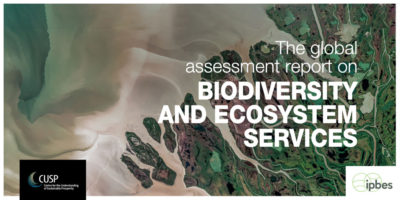Why SME finance markets need to act fast to address nature as well as climate
Business and finance play a key role in advancing the biodiversity and climate agenda. Small and medium size enterprises (SMEs) receive too little attention in the quest. Work by CUSP researchers at Middlesex University shows that it overlooks both the overall economic contribution of SMEs, as well as their environmental impacts.
Blog by Robyn Owen, Amy Burnett and Fergus Lyon

COP15 in Montreal demonstrated that putting a workable ‘value’ on Nature is required in our current economic system to enable global financial systems to operate effectively to help achieve the ‘30 by 30′ agreement, with its goal of conserving at least 30% of Earth’s land and water by 2030. To quote UK Environment secretary Therese Coffey from her speech at the beginning of the UN biodiversity conference, there’s an urgent need “… to see natural systems restored, populations of species recovering, and extinctions halted by 2050 alongside strengthened reporting and review mechanisms that will hold all of us to account”.
Business finance will play an important part in addressing the huge biodiversity challenge. Increased environmental reporting standards, presented for example in the UK Greening Finance Roadmap and the EU Green Taxonomy’s six environmental objectives, bring together climate mitigation and adaptation with wider environmental resource protection, pollution control and circular economy considerations. The UK’s Environment Act 2021 had already introduced the requirement for at least 10% Biodiversity Net Gain (BNG) in planning activities from 2023.
Whilst environmental and sustainable business reporting standards are improving, far too much reliance on narrative statements of intent has thus far encouraged a culture of greenwashing and a focus on—much easier to calculate—Net Zero CO2 (and wider Greenhouse Gas) mitigation, rather than wider environmental impact assessments relating to circular economy and biodiversity—which are more complex and difficult to measure.
The recent NGFS’s Central banking and supervision in the biosphere agenda for assessing financial risk highlighted the need for science-based target measures to address biodiversity loss and direct business investment into ‘nature positive’ actions. The paper further identifies the synergies potential of coupling Climate and Biodiversity to optimise progress to the global Net Zero 2050 target. The report showcases examples of rewilding, land, sea, freshwater and pollination activities which all contribute to natural carbon capture, improve food and water security, support the regeneration of raw materials, and work towards the mitigation of potential future severe weather costs.
Yet, two fundamental problems persist: First, there are still no clear measures or universally accepted science-based targets for biodiversity and nature positive mitigation impacts to inform the finance markets. To this effect, the Taskforce on Nature-related Financial Disclosures (TNFD) released its latest framework recommendations to align global reporting for climate and nature. We have to see where this will lead. Second, environmental reporting is so far only really required from larger companies. In the UK, only businesses with over 500 employees are typically tasked with reporting on their environment, sustainability and governance (ESG) status. This overlooks both the important contribution that small and medium-sized enterprises (SMEs) make to the economy (they typically represent 99% of private businesses and over half of employment and GDP in OECD economies) and the environmental impacts they have—in Europe alone, SMEs account for 60-70% of industrial pollution.
How can this be addressed?
SME financing for biodiversity
Latest research by Middlesex University CUSP researchers for the Natural Environment Research Council (NERC) and Business for Biodiversity (B4B) into SME Financing for Biodiversity (‘SME FinBio’) focuses on current approaches to SME biodiversity risk reporting and the incentives that can encourage more of this.
Set out to feed recommendations into the TNFD and to policymakers, the work is providing practical guidance to SMEs and their investors for bringing in screening and monitoring for nature positive alongside net zeroconsiderations.
Our approach
We consulted with over 150 stakeholders in the UK SME finance market, including banks, investment banks, equity investors, accountants, ESG consultants, business finance support providers and government departments and agencies (including Innovate UK, BEIS, Defra and the British Business Bank). 11 business case studies explored larger businesses and their greening of SME supply chains, B Corp accredited SMEs that self-report their environmental impacts to present their green credentials to the market and SME innovators that are driving changes in environmental business models and measurements.
What we Found
The research revealed five key barrier themes for policymakers and the SME finance markets to address:
1. Public policy, planning and regulation
There is a need for a consistent and coherent policy mix to create an effective UK green SME investment policy roadmap that goes beyond usually large-scale infrastructure investing and that encourages early-stage green innovation. Bringing together BEIS Net Zero with Defra Nature Positive SME support would help to provide a clearer and more powerful message to SMEs and their support providers, notably through central and local government agencies. A suitably informed, incentivised and regulated land asset value offsetting and insetting (within the company’s own value chain) market is urgently required to facilitate the desired biodiversity net gain and develop the improved nature valuation and operation of finance markets.
2. Measurement and metrics
Biodiversity land management requires national reporting standards set to decision grade data (i.e. based on science-based targets and enabling effective benchmarking for environmental impact). A finding that chimes with challenges set by the NGFS Central Bankers and the TNFD, respectively. It requires clearly defined science-based targets with sectoral settings to ensure that high environmental impact sectors such as agrifood, infrastructure, manufacturing and engineering, and other land and water-based activities (such as mining, forestry, utilities, ecotourism) are properly addressed. Adopted reporting metrics must be practical and achievable for typically less well-resourced SMEs.
3. Investment incentives
SME innovators are leading in the practical delivery of new measuring systems for biodiversity and nature positive (see for example NatureMetrics, Watr.Tech and BX). Whether we look at investors who want to finance SME innovators (SMEs that are developing green/ environmental innovations), or SME innovation adopters themselves who wish to invest in adopting new green innovations and practices, there’s no way around improved metrics to help with risk perception and calculate the environmental value, as well as the economic value of the innovation (Harrer and Owen, 2022). Better interconnectivity between different investors and financial market actors can enhance the design and use of measures and applications for biodiversity reporting and risk assessing in investment and financing portfolios. Small business innovators are already driving new innovative business models and influencing supply chains (by introducing value-added services and products, for example, see BX), whilst larger reporting business can play an important role in guiding and financing the greening of their SME supply chains.
4. Messaging, accreditation and labelling
Interdependencies between climate, biodiversity, business and investment requires consistent messaging through coordinated tools and support resources to businesses and financial services, and notably, SMEs. Smaller businesses need to understand the benefits from green practices to protecting their markets and obtaining kudos via self-reporting (exemplified by B Corps). Light touch regulation, alongside one-stop-shop accreditation portal support offering checker tools and simple environmental auditing approaches can help raise awareness and offer a practical and credible SME green grading system (based on energy and environmental impact ratings) that can help investment decision making and improve the efficiency of green SME supply chains.
5. Intermediary extra financial services (private and public services)
Far more needs to be done to raise awareness of climate and particularly nature positive needs and potentials amongst SMEs. Alongside the appeal of ESG scoring of SMEs, extra financial services (e.g. the business management, networking and expert market support that can assist business financing and performance) provided by ESG consultants and public/private support agencies can offer cutting-edge solutions to both businesses and financiers, across all parts of the market. Mapping impacts is important, as is the ability to connect projects and generate aggregate learning, capacity building and impacts between SMEs and localities and avoidance of small-scale silos. Breaking the silos will be critical to delivering an effective SME green finance ecosystem and increasing the levels of green impact investing.
Link
We have published our findings in much more detail. You can find out more about the project and access our outputs, including key policy recommendations and a toolkit for sustainable net-zero and climate positive investment aimed at financiers and business on our project webpage.

Announcement
We are delighted to announce that new research has just been commissioned by UKRI and NERC for 2023. This will enable the Middlesex team—in collaboration with ecologists from the University of Reading and leading sector specialist partners—to explore the SME finance markets in four high risk environmental impact sectors: agrifood, infrastructure (including transport and construction), sustainable fashion and advanced manufacturing technology. Watch this space for further details soon.



